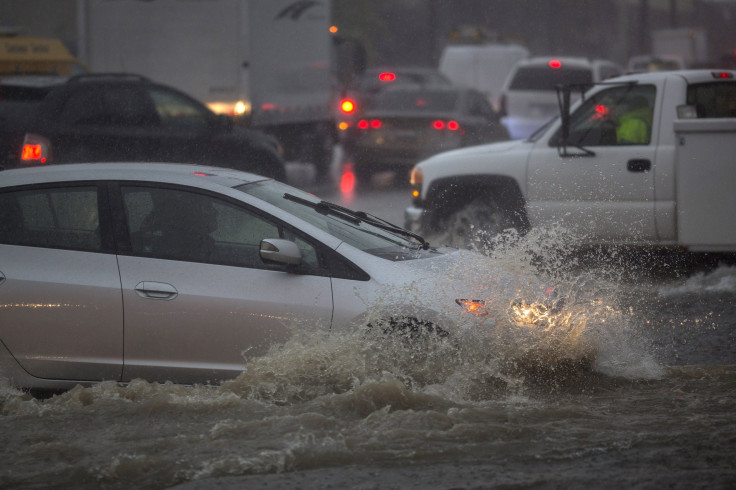California Flooding Pictures And Videos: Heavy Rains, Severe Weather Prompt Evacuations [PHOTOS]

A second barrage of rain hit Northern California Tuesday, causing flash floods and prompting evacuation orders in multiple areas. At least part of the blame fell on a weather condition known as an atmospheric river, a common occurrence in which narrow portions of the atmosphere snake through the sky, bringing rain, wind and snow as they travel. Most atmospheric rivers pass by unnoticed, but some, like Tuesday’s, lead to heavy flooding and other dangerous conditions.
After a continuous storm Monday, rain began to slow Tuesday, though many rivers and creeks in the area already had reached capacity. The Dom Pedro Reservoir in Tuolumne County opened its spillway gates for the first time in nearly 20 years as officials warned the river’s waters would likely rise above flood levels. Residents of surrounding communities were not forced to evacuate but were urged to move to higher ground, the Los Angeles Times reported.
“Continued runoff and high stream flows will stress levees leading to bank erosion, boils and breaches,” the National Weather Service said in a flood warning Tuesday. “Flooding has occurred in locations that have not experienced flooding in many years.”
An estimated 2,000 people were left stranded Tuesday in Spring Valley after mudslides and flooding blocked all entrances to the rural community. At the Los Lagos Golf Course in San Jose, at least five people were rescued after Coyote Creek overflowed and flooded a homeless encampment. Officials warned several portions of highways, including Highway 50 in El Dorado County, were in danger of collapsing after the shoulders were washed away by the storms.
In addition to the deluge, the storm brought severe winds in the area. Record wind was recorded in the Sierra Nevada Monday during the strongest part of the storm, when gusts reached 199 mph.
The photos and videos below show the storm’s impact on Northern California.
Don Pedro Spillway Gate opened for the first time in 20 years. @NealKarlinsky is in northern California for us! Video: @TuolumneSheriff pic.twitter.com/xp6a7dEIA2
— Ginger Zee (@Ginger_Zee) February 21, 2017
~30 homes in San Jose at Senter Rd. flooded. Residents stranded. Water contaminated. Firefighters ordered to wear protective suits #ABC7now pic.twitter.com/RiVWc3LluE
— David Louie (@abc7david) February 21, 2017
@SJFD handling major flooding avoid the area Senter and Phelan pic.twitter.com/5nREMAUBZZ
— San José Fire Dept. (@SJFD) February 21, 2017
Residents rescued from Nordale neighborhood in #SanJose where floodwaters from Coyote Creek are rising. #abc7now pic.twitter.com/EMQy8rQFIa
— David Louie (@abc7david) February 21, 2017
Evacuations, levee break as storms drench Northern California https://t.co/B9Zxi568LT pic.twitter.com/k9yZhNbEyA
— CBS News (@CBSNews) February 21, 2017
Live: Crews rescuing people from flood waters in San Jose, CA. https://t.co/JFYnDqYrH7 #cawx pic.twitter.com/IV0BAxf6lh
— Ian Schwartz (@SchwartzTV) February 21, 2017
STORMWATCH: Much of the Santa Cruz Mountains is under a flood warning; rivers and creeks in the area could crest: https://t.co/hQsZwmhmRq
— ABC7 News (@abc7newsbayarea) February 21, 2017
Homeless encampments along #SanJose's Coyote Creek have been overwhelmed by a flash flood. Rescues underway. https://t.co/OI1kDDnfaU pic.twitter.com/4cChKpR9A3
— KCBS 106.9 FM/740 AM (@KCBSRadio) February 21, 2017
Storm runoff causing a surge on the San Lorenzo River in Boulder Creek but not spilling over. #abc7now pic.twitter.com/VPGMbUmw0r
— David Louie (@abc7david) February 20, 2017
© Copyright IBTimes 2025. All rights reserved.






















